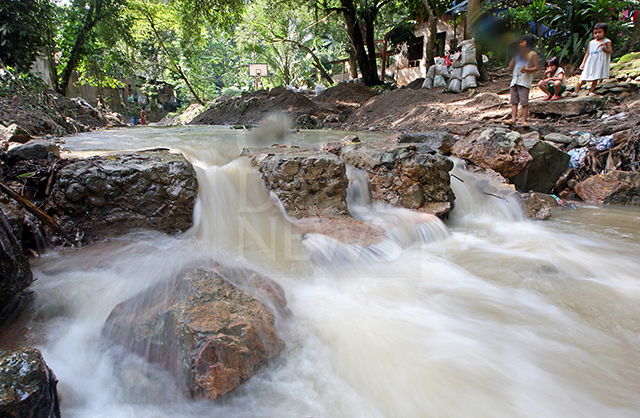
Excess water spills from Buhisan dam in this 2013 photo. With prevailing El Nino weather phenomenon, surface water sources in Metro Cebu are reportedly drying up. But MCWD has assured that water supply from Buhisan dam is still enough. (CDN FILE PHOTO)
A WATER firm offered to allocate the excess water produced by its desalination plant at the South Road Properties (SRP) to address Metro Cebu’s water shortage.
Antonio Tompar, Pilipinas Water Resources Inc. (PWRI) president, said he wants to see a “rationalized and sustainable” solution to the ongoing water problem experienced by Metro Cebu due to the ongoing El Niño dry spell.
“I would like to stress that we are willing to supply excess water to Cebu City to help solve this problem,” he said in a press conference at the Cebu City Sports Club yesterday.
The Cebu Provincial Board approved a resolution asking the Cebu Chamber of Commerce and Industry and the Metropolitan Cebu Water District (MCWD) to “spearhead a program that will provide a long-term solution to the effects of El Niño.
“Tompar said they are working with the Cebu city government and MCWD to augment water supply in its service areas. “Both parties are amenable to the idea so far,” he said.
The facility can supply 10,000 to 15,000 cubic meters of water daily at less cost than commercial rates.
The desalination plant, which converts brackish underground water into potable water, can process up to 22,000 cubic meters a day.
Tompar said the whole SRP consumes only 3,000 cubic meters per day, with the recently opened SM Seaside City Cebu using more than 60 percent of the supply.
It can also treat up to 8,000 cubic meters of wastewater per day.
When the plant opened in 2013, it sold its water at P47 to P49 per cubic meter.
Tompar said they now sell water at more than P50 per cubic meter.
The company partnered with Mactan Rock Industries, Inc. (MRII), which built and will operate the plant for 30 years.
PWRI also entered into an agreement with the city government to exclusively supply water to locators in the SRP.
Tompar said he will ask the Cebu City Council to amend the contract which bars PWRI from supplying water outside the SRP.
“(By amending the) contract, we can supply water within Cebu City,” he said.
Tompar said he asked the MCWD board and the Cebu city government to declare a “state of emergency” to expedite the process.
In a statement sent to Cebu Daily News, MCWD said it “welcomes any offer for additional bulk water supply as long as the price is reasonable.”
It reiterated its mandate to provide affordable and reliable potable water services.
The MCWD earlier projected a water shortage of 34,000 cubic meters per day due to the El Niño between April and May this year.
Charmaine Rodriguez-Kara, MCWD spokesperson, said their latest tests show that the district’s supply is still at a normal level which means they can still produce 220,000 cubic meters daily, servicing 169,000 households.
“What’s unusual is that it’s been raining in the last few days. But once the rains don’t come anymore as forecast previously, then we will be experiencing low water pressure like that during the first week of February last year,” she said.
The MCWD encouraged its consumers to conserve water in anticipation of a drought this year.
The MCWD commissioned other bulk water suppliers to lower the shortage to 4,600 cubic meters.
MCWD relies mostly on groundwater sources, which account for 80 percent of its daily production, while the remaining 20 percent comes from surface water sources.
Among its major surface water sources are the Buhisan Dam, which produces 7,000 cubic meters of water per day, and the Jaclupan Facility, producing 33,000 cubic meters a day.
Kara said the first to be affected are the surface water sources.
Last year, the supply from the Jaclupan facility went down to 8,000 cubic meters per day while the water supply from the Buhisan went down to 1,000 cubic meters daily.
The Mactan office of the state weather bureau Pagasa said the El Niño dry spell still persists.
“This month the average weather temperature is 30.2 degrees Celsius but the projected temperature will be 31 to 32 degrees Celsius,” weather specialist Romeo Aguirre said.
Average normal rainfall for February is 77.8 millimeters of rain. “But it will be 20 to 60 percent reduction of rains expected this month,” he said.
Last January, Pagasa recorded 116.4 millimeters of rain in Cebu, lower than the average normal rainfall of 126.4 millimeters.
“There were only eight days of rain last month from January 25 to January 27,” he said.

